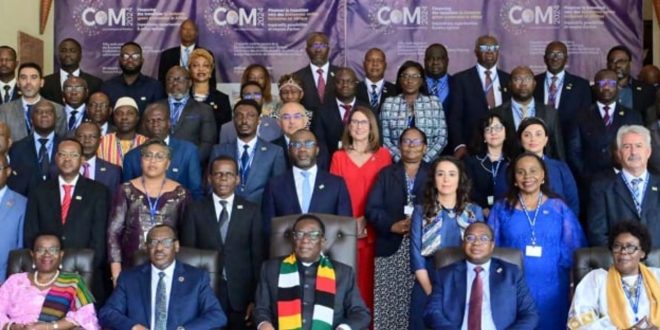The United Nation Economic Commission for Africa (UNECA) has recently published a report which provides a snapshot of AfCFTA implementation strategies in the continent, with a list of the countries and the Regional Economic Communities (RECs) that have adopted them and a description of their core elements, the process by which they were developed, and experiences of some African states in their implementation.
The AfCFTA implementation strategies are policy documents that define strategies for expediting the implementation of the AfCFTA Agreement and realize its benefits at national and regional levels. They are based on a decision adopted by the Conference of African Ministers of Finance, Planning and Economic Development, that in a meeting held in Addis Ababa in May 2018, urged the African Union member States to prepare national strategies and implementation plans to identify opportunities, constraints and actions related to the AfCFTA implementation, including key objectives for increasing trade performance, country priority sectors, and opportunities for regional and global value chain integration. Such strategies have neen developed by both African States and RECs (at the moment only 3 RECs have completed them: IGAD, EAC and ECOWAS), and highlight the priority actions that must be undertaken by State Parties or RECs in the short to medium in order to advance the AfCFTA agenda. More specifically, they:
- Provide a framework through which State Parties have to implement the AfCFTA;
- Assess the adequacy of the institutional and legal/regulatory infrastructure, identifying reform needed in order to implement the AfCFTA Agreement effectively and in an inclusive and envi- ronmentally sustainable manner;
- Highlight the trade and development opportunities presented by the Af- CFTA;
- Identify and assess the main constraints, challenges and gaps that need to be addressed in order to realize AfCFTA opportunities;
- Identify sectors of priority interest in which each of the State Parties see potential competitive advantages and opportunities for the development of industry clusters and regional value chains;
- Design strategic pathways and policy transformations to advance the imple- mentation of the AfCFTA; and
- Outline implementation action plans/ workplans that provide a framework through which these strategic pathways will be implemented.
In order to harmonize the criteria for developing such strategies, UNECA, in collaboration with the African Union Commission, developed a set of ‘Guidelines for Developing AfCFTA Strategies’ with the aim of providing a common but flexible structure for their preparation. The major recommended components of such strategies include an analysis of the State Party’s macroeconomic environment, production and trade performance; key opportunities and priority sectors for production and trade, constraints and potential implementation risks to overcome; proposed strategic actions to address potential obstacles, together with an action plan/matrix; a monitoring and evaluation frame- work; and a communication plan.
The UNECA report describes the challenges encountered in developing such strategies and lessons learned. In particular, the study concludes that:
a) some countries lack of comprehensive and accurate data on macroeconomic & trade history, especially for the service sectors. This makes particularly hard to assess the services sector performance in many countries. For some countries, it was necessary to use mirror data to calculate merchandise trade, which reduced the accuracy level in justifying the prioritized strategic pathways.
b) The majority of todays AfCFTA implementation strategies were developed at a time when only a fewprotocols (on trade in goods, trade in services, and dispute settlement) were in place. Even rules of origin wereincomplete at the time when such strategies were developed. Now we have the Phase II protocols on competition policy, intellectual property frights, investment, digital trade, and women and youth in trade (this one still under negotiation), that are completed but not yet ratified. The AfCFTA implementation strategies will need to be revised to address these new instruments. An example is the EAC strategy, that is now being revised to incorporate the new developments at the AfCFTA.
c) There has been no coordination in sequencing the development of regional and national strategies. Two regional strategies, the ones for the EAC and ECOWAS, were completed sometime even though they have yet to be commissioned. On the other hand, many member states in these RECs had their national strategies validated and it remains unclear on the extent to which they are consistent with the mandates and goals identified in the regional strategies. State Parties may therefore consider involving their RECs in the development and validation of their national strategies.
d) The report draws attention to the challenges faced by many countries in forming or reactivating their National Implementation Committees (NICs) to oversee the implementation of the AfCFTA strategies due to multiple factors, including insufficient human and financial resources to establish and maintain new or additional committees on the AfCFTA. A solution that could be considered is the approach adopted by some countries of giving to their National Trade Facilitation Committees (NTFCs) also the mandate to coordinate the AfCFTA implementation.
e) The development of AfCFTA strategies has faced delays in many countries and for many reasons. The process should normally take between six to 12 months, including the scoping mission, the hiring of consultants, conduct of literature review, organization of consultations and sensitization workshops, validation of the draft strategy document, and official launch of the approved strategy. However, these steps in most cases have taken longer. But, in countries that (for example) had already undertaken robust studies on their trade and/or industrial policies, the development of their national strategies took much shorter period.
f) Both UNECA and the national focal persons usually prefer to hire local consultants who understand and can articulate the national context into drafting the strategy. However, the expertise has proven hard to find in many countries. In a few cases, the calls for consultants have been put out several times, attracting very few applications, while sometimes the poor quality of consultants has resulted in poor quality work, necessitating either ECA technical intervention and or hiring other consultants to complete the work at extra cost.
source: https://www.ddcustomslaw.com/
Image : AI generated





